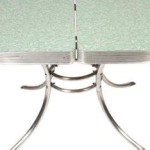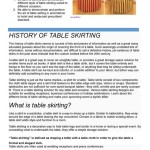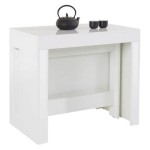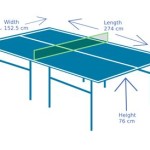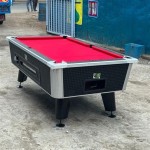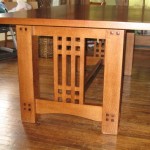How Does A Drop Leaf Table Work?
A drop leaf table is a versatile piece of furniture characterized by its hinged leaves that can be folded down to reduce the table's surface area or raised to expand it. This adaptability makes it a popular choice for spaces where flexibility is desired, such as apartments, dining rooms used for multiple purposes, or smaller kitchens. The functionality of a drop leaf table relies on a combination of structural design and mechanical components that enable the seamless transition between its compact and expanded states.
Understanding the mechanics of a drop leaf table involves examining the various parts and how they interact to support the leaves. Key elements include the table top itself, the hinged leaves, the support structures (often legs or brackets), and the hardware that facilitates the folding and unfolding action. The design of these components determines the stability and ease of use of the table.
The Anatomy of a Drop Leaf Table
The core structure of a drop leaf table commonly consists of a central surface, often referred to as the table's “main body.” This section remains fixed, forming the foundation upon which the drop leaves are either supported or folded against. This main body often houses the legs or the underframe that provides the table with its primary support.
The leaves are the defining feature of a drop leaf table. These are sections of the tabletop that are attached to the main body via hinges. The hinges allow the leaves to pivot, moving between a horizontal, extended position and a vertical, dropped position. The size and shape of the leaves can vary depending on the overall design of the table, with some leaves being rectangular, while others may be curved or shaped to create a circular or oval table when extended.
The hinges used in drop leaf tables are typically designed for durability and smooth operation. Common types include butt hinges or piano hinges, chosen for their ability to withstand repeated use and provide a secure connection between the leaf and the main table body. The placement and alignment of the hinges are critical for ensuring that the leaves sit flush with the main table surface when raised, creating a uniform and stable tabletop.
Support structures are essential for maintaining the stability of the leaves when they are raised. These supports can take various forms, including hinged brackets, swinging gate legs, or sliding supports. The type of support used often depends on the style and size of the table, as well as the desired aesthetic.
Hinged brackets are a common support mechanism. These brackets are attached to the underside of the table and swing outwards to provide support to the leaf. A locking mechanism is often incorporated to secure the bracket in the supporting position, preventing the leaf from collapsing unexpectedly. The design of the bracket should be robust enough to bear the weight of the leaf and any items placed upon it.
Swinging gate legs are another frequently used support option, especially in older or more traditional drop leaf tables. These legs are attached to the underside of the table with hinges, allowing them to swing outwards to support the leaves. When not in use, the gate legs fold inwards, flush against the table's frame. Gate legs often contribute to the table's overall aesthetic, adding a decorative element to the design.
Sliding supports, while less common, provide a simple and effective means of supporting the leaves. These supports consist of wooden or metal bars that slide out from beneath the table's frame to provide a stable surface for the leaves to rest upon. They are typically held in place by friction or a simple locking mechanism.
The Mechanics of Extending and Collapsing the Table
The process of extending a drop leaf table involves a sequence of actions designed to smoothly transition the table from its compact to its expanded state. The first step typically involves releasing any locking mechanisms that secure the leaves in their dropped position. This might involve disengaging a latch or simply lifting the leaf slightly to free it from its resting place.
Once the locking mechanism is released, the leaf is then raised to its horizontal position. This involves pivoting the leaf around the hinges that connect it to the main table body. The hinges should allow for a smooth and controlled movement, ensuring that the leaf rises without sticking or binding.
With the leaf raised, the support structure is then deployed to provide stability. If the table utilizes hinged brackets, these are swung outwards and locked into place. For tables with swinging gate legs, the legs are swung outwards until they are perpendicular to the table's frame, providing a solid foundation for the leaf. In the case of sliding supports, these are pulled out from beneath the table until they fully support the leaf.
The process of collapsing the table is essentially the reverse of the extension process. The support structure is first disengaged, whether it be unlocking the hinged brackets, folding in the gate legs, or retracting the sliding supports. The leaf is then lowered, pivoting around the hinges until it rests in its dropped position. Finally, any locking mechanisms are engaged to secure the leaf in place.
The ease of extending and collapsing a drop leaf table depends heavily on the quality of the hinges and support mechanisms. Well-designed and properly maintained hinges will allow for smooth and effortless movement of the leaves, while robust support structures will ensure that the table remains stable when fully extended. Regular maintenance, such as lubricating the hinges and tightening any loose screws, can help to ensure that the table continues to function properly over time.
Design Variations and Considerations
Drop leaf tables come in a multitude of designs, each with its own unique characteristics and functional considerations. The size and shape of the table, the style of the legs, and the type of support mechanisms used can all vary significantly, reflecting different aesthetic preferences and practical requirements.
The size of a drop leaf table is a primary consideration. Smaller tables, suitable for kitchens or small dining areas, may have relatively small leaves that provide a modest increase in surface area when extended. Larger tables, designed for more formal dining rooms, may have larger leaves that significantly increase the table's capacity. The size of the leaves will influence the type of support structure required, with larger leaves often requiring more robust supports.
The shape of the table is another important design element. Drop leaf tables can be rectangular, square, round, or oval. Rectangular and square tables are often chosen for their versatility and ability to fit well in various room layouts. Round and oval tables can create a more intimate dining experience and may be preferred for smaller spaces. The shape of the leaves will typically complement the shape of the main table body, creating a cohesive and visually appealing design.
The style of the legs can also vary considerably. Some drop leaf tables have simple, straight legs, while others have more decorative, turned legs. The legs can be made of wood, metal, or a combination of materials. The style of the legs should be consistent with the overall aesthetic of the table and the room in which it will be used. Gate leg tables are a specific style where the leg itself swings out to support the leaf, adding a historical design element.
Material selection is also crucial. Hardwoods like oak, maple, and cherry are popular choices for drop leaf tables due to their durability and aesthetic appeal. Softwoods like pine may be used for more rustic or budget-friendly designs. Metal can also be incorporated into the table's construction, particularly for the legs or support structures. The choice of materials will affect the table's weight, strength, and overall appearance.
Beyond the basic mechanics, design considerations also include the ease of use and storage of the table. Tables with smooth, easy-to-operate hinges and support mechanisms will be more convenient to use on a regular basis. Some drop leaf tables are designed to be easily disassembled for storage, making them ideal for situations where space is limited. The finish of the table is also important, as it should be durable and resistant to scratches and stains. A well-designed drop leaf table will seamlessly blend functionality and aesthetics, providing a versatile and attractive addition to any home.

David Boeff Furniture Maker Drop Leaf Cherry Table Making The Supports Step 7

Drop Leaf Work Or Craft Cart

Guide To Drop Leaf Tables

Drop Leaf Work Or Craft Cart

Drop Leaf Work Or Craft Cart

Drop Leaf Work Or Craft Cart

The Buyers Guide To A Wall Mounted Drop Leaf Table

Watch Me Build A Stunning Drop Leaf Table In Minutes With Cnc Machine Part 1 Introduce Project

Cottage Inspired Drop Leaf Side Table Confessions Of A Serial Do It Yourselfer

Drop Leaf Work Or Craft Cart

